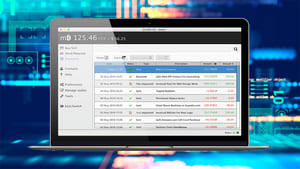Blockchain Technology and How Does It Work:
Blockchain has gained rampant recognition around the world, with more companies deploying the use of the technology in a variety of industries like finance, healthcare, and supply chain management to name a few. Blockchain technology is a decentralised and distributed ledger, that tracks assets and records transactions and ownership of digitalised assets. Virtually anything can be tracked and traded on a blockchain network, and once the data has entered the network, it cannot be modified. As everything, from cutting costs to reducing risk is tracked, and data is unalterable, blockchain remains a legitimate disruptor for industries like cybersecurity, healthcare and payments.
The history of any digital asset is transparent in this decentralised network. Initially, this technology was created with an underlying design for the digital currency, Bitcoin, however, over the years, the potential has increased beyond the cryptocurrencies.

Crash Course on Blockchain & Bitcoin Trading for Novice 2019
Last Updated: 2022-04-21
Learn the key concepts around Blockchain and Bitcoin.
Features of Blockchain:
- Blockchain is a distributed ledger, made up of a series of blocks and in each block is listed a series of transactions. When a transaction takes place, it is added to a new block, and once the entries of the block are verified by multiple networks of computers, this is added to the chain of blocks, wherein this transaction remains permanently, and unalterable. Distributed ledger technology eliminates the duplication of data as seen in different industries.
- Blockchain is decentralised, meaning that there is no single entity or organisation of control for its functioning, therefore making it more secure, as well as resistant to the tampering of pieces of evidence or manipulation of data by an authority.
- Blockchain has a transparent network, due to which the same piece of information is available to all the users, therefore increasing accountability, and making it well-suited for all the organisations of various industries.
- Immutable records, therefore even if there is an error in the data, a new transaction has to be added to reverse the error, and both transactions are then visible.
How are companies using blockchain?
Blockchain is used in various industries, like blockchain supply chains, and financial and healthcare sectors. Following are examples of different ways blockchain is used:
- Blockchain is used to streamline and improve financial services, like digital payments and remittances, and ensures faster transactions without the requirement of intermediaries.
- Companies can use blockchain to track the entire journey of products, from production to reach the consumer, thereby increasing transparency and reducing fraudulent errors during transactions.
- Data of patients can also be tracked and maintained, enabling better coordination of care and reducing the risk of medical errors.
- Blockchain is used to facilitate the process of buying and selling real estate, reducing the need for intermediaries and increasing transparency in the process.
- Decentralized platforms for gaming and digital collectables are created using blockchain technology that enables players to own and trade in-game assets in a secure and transparent manner.
- Blockchain is being used to increase transparency and accountability in philanthropy, enabling donors to track the impact of their donations and ensuring that funds are being used for their intended purpose, thus eliminating any possibility of misuse of funds.
How does Blockchain work?
Blockchain ledger works in the following step-to-step transactional process:
- A transaction is initiated by the user, like sending money or updating digitalised assets.
- The transaction is broadcasted to multiple networks of computers for the verification of the data.
- Once the transaction is verified by complex algorithms to verify the authenticity, a permanent and unalterable block is created, transparent to all.
- The ledger, which is a record of all the transactions is updated with the newest entry.
- The transaction is completed and opens for everyone to see.
Advantages and Disadvantages:
Pros:
- Due to decentralisation, no entity controls blockchain technology, therefore making it more secure and transparent.
- Transactions are secured through encryption and a consensus mechanism making it difficult to hack.
- Transparent information to every user.
- Immutable records are maintained.
- As there are no intermediaries, efficiency is increased and the cost is reduced.
Cons:
- The main issue is scalability, wherein it lags to process a large database.
- Due to complexity, it is not easier to implement
- Limited by regulations and government policies, therefore not everyone can use it in a compliant manner.
- Currently, there are many different blockchain platforms and networks, which can make it difficult to transfer data or assets between different systems.











